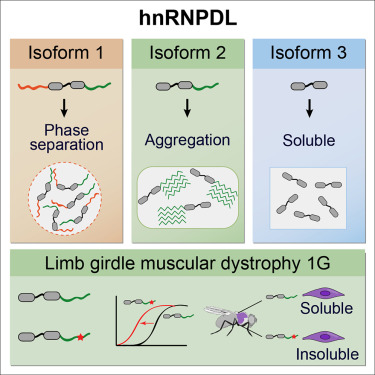https://doi.org/10.1016/j.celrep.2019.12.080
Highlights
-
hnRNPDL requires both N- and C-terminal IDRs to phase separate
- The absence of N-terminal IDR facilitates aggregation
-
The unique combination of IDRs in each isoform determines its cellular behavior
-
D378N/H mutations accelerate hnRNPDL aggregation and compromise its solubility
Summary
Prion-like proteins form multivalent assemblies and phase separate into membraneless organelles. Heterogeneous ribonucleoprotein D-like (hnRNPDL) is a RNA-processing prion-like protein with three alternative splicing (AS) isoforms, which lack none, one, or both of its two disordered domains. It has been suggested that AS might regulate the assembly properties of RNA-processing proteins by controlling the incorporation of multivalent disordered regions in the isoforms. This, in turn, would modulate their activity in the downstream splicing program. Here, we demonstrate that AS controls the phase separation of hnRNPDL, as well as the size and dynamics of its nuclear complexes, its nucleus-cytoplasm shuttling, and amyloidogenicity. Mutation of the highly conserved D378 in the disordered C-terminal prion-like domain of hnRNPDL causes limb-girdle muscular dystrophy 1G. We show that D378H/N disease mutations impact hnRNPDL assembly properties, accelerating aggregation and dramatically reducing the protein solubility in the muscle of Drosophila, suggesting a genetic loss-of-function mechanism for this muscular disorder.

